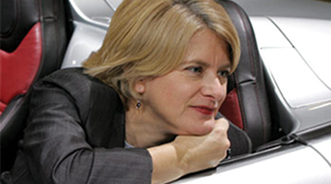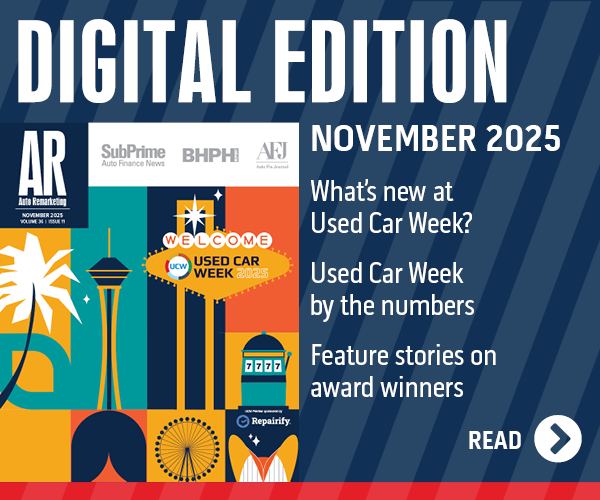Edmunds.com Discusses Rising Used-Vehicle Prices, Other Notable 2010 Industry Trends

By subscribing, you agree to receive communications from Auto Remarketing and our partners in accordance with our Privacy Policy. We may share your information with select partners and sponsors who may contact you about their products and services. You may unsubscribe at any time.
SANTA MONICA, Calif. –
In a look back at some of 2010’s most revealing industry trends, Edmunds.com attributed rising used-vehicle prices to high demand caused by the “substitution effect.”
Site analysts outlined this condition as a reaction to the economic downturn. They said shoppers who had traditionally been new-vehicle buyers ultimately bought used units.
Based on December 2010 data, Edmunds.com determined the average used-vehicle transaction price stood at $19,345. At the same month a year earlier, the site put the figure at $16,586.
Throughout last year, site analysts thought used-vehicle prices were generally 10 to 15 percent higher than in 2009.
“Consumers have been willing to either substitute premium for non-premium cars or consider used and certified pre-owned cars instead of new,” explained Edmunds.com senior analyst Karl Brauer.
“Ironically, thanks to reduced supply and increased demand, today many lightly used pre-owned cars are actually more expensive than new cars,” Brauer continued. “But, because that is counterintuitive, many used-car shoppers aren’t even considering a new car.”
Subscribe to Auto Remarketing to stay informed and stay ahead.
By subscribing, you agree to receive communications from Auto Remarketing and our partners in accordance with our Privacy Policy. We may share your information with select partners and sponsors who may contact you about their products and services. You may unsubscribe at any time.
Because of a limited supply of used vehicles, Edmunds.com analysts still expect 2010 used-vehicle sales to be off by 3.7 percent compared to 2009.
And despite the “substitution effect,” the site still contends 2010 new-vehicle sales should climb 11.6 percent year-over-year.
Trucks & Midsize Cars Sold Better Than Compacts & Hybrids
As Edmunds.com highlighted gains for new-vehicle sales, the site pointed out that the positive movement isn’t happening for all segments with some doing much better than others.
Analysts asserted that stable gas prices meant consumers — and especially those who had been putting off their vehicle purchases during the recession — have been more willing to buy trucks and SUVs. As a result, Edmunds.com expects 2010 truck sales to be up 14.9 percent and SUV sales to climb 21.3 percent over 2009.
Meanwhile, Edmunds.com projected midsize car sales to be 7.8 percent higher when 2010 figures are finalized.
On the flip side, the site contends hybrid sales should be down 8.1 percent, while compact car sales should move just 1.1 percent higher.
Edmunds.com senior analyst Michelle Krebs tried to shed some light on these sales trends.
“Many of the new trucks and SUVs were bought to be used as work vehicles by contractors and others who had delayed their purchases waiting for the economy to improve,” Krebs offered.
“The midsize car segment also was a big winner last year since it had impressive new products and captured the relatively conservative mood of car buyers,” she continued.
“Hybrids and compact cars, on the other hand, weren’t such strong sellers,” Krebs went on to say. “There weren’t many new players in the compact car segment to draw in attention and, because of the economy, many traditional compact car buyers likely bought used cars if they bought anything at all.”
Most Automakers Reduce Incentives, Except Japanese Brands
Analysts found the Edmunds.com True Cost of Incentives data showed incentives fell for domestic, European and Korean brands year over year. However, they noticed Japanese automakers increased their incentives in 2010.
While Japanese brands remained the lowest in average incentive spending with $1,968 per vehicle sold in 2010, Edmunds.com determined it was still a notable increase from the $1,637 spent per unit in 2009
Analysts also learned domestic OEMs averaged $3,333 in incentives per vehicle sold versus $3,766 in 2009. They said Korean brands averaged $1,820, down from $2,721 in 2009.
Edmunds.com went on to point out that European automakers had the greatest decline in incentives, averaging $2,491 in spending per vehicle, down from $3,295 in 2009.
Recalled Vehicles & Complaints Rise
According to Edmunds.com’s analysis of National Highway Traffic Safety Administration data, safety recalls affected 19.1 million vehicles in 2010, up dramatically from the 13.4 million vehicle annual average from 2005-2009.
Furthermore, the site determined nearly 41,000 complaints have been registered for model years 2005-2010 in the NHTSA database during 2010 — more than twice than 2009.
“Looking at the year-over-year trends, typically the number of complaints goes up between 3,000 and 5,000 annually as more people discover the online complaints submission process,” Edmunds.com analyst Panee Segal explained.
“However, the Toyota recalls cast a much brighter spotlight on this process. It will be interesting to see if the trend continues into the future when recalls aren’t earning front page headlines,” Segal added.
Despite all the attention to recalls in 2010, Edmunds.com found the number of NHTSA recall campaigns declined to 165 compared with 175 in 2009.
Drivers Benefited from More Technology
Edmunds.com conceded technology continues to get more deeply embedded in vehicle as features aim to make units safer, more efficient and more convenient. The site identified its Top 10 Car Technologies for 2010 and offered commentary about each one.
Audi MMI Touch
“Audi’s Multi Media Interface is already one of the better knob-centric solutions for navigating through the thicket of electronic features found in most luxury cars,” Edmunds.com offered. “With the introduction of its 2011 Audi A8, Audi has improved the interface with the first automotive application of a touch pad, called MMI Touch. The feature allows drivers to trace characters with a finger to access navigation destinations or find contacts in a connected Bluetooth phone. This method may be quicker than entering the info by finding letters and numbers one character at a time, but it’s also accompanied by voice activation — just in case Audi drivers don’t want to let their fingers do the talking.”
BMW iPod Out
“It might not seem like a big deal that BMW has used the little-known spec of Apple’s iOS4 software called iPod Out to send the iPod’s graphic user interface to a car’s in-dash display,” analysts explained. “And from a technology standpoint, it isn’t. But it is a momentous step for an automaker that prides itself on in-house innovation to cede the GUI to a second party. It’s also a sign of what might be to come. The immediate payoff is that the BMW interface is always as current as the software on the iPod, offloading that troublesome task to the device and its owner instead of the vehicle and its maker. BMW has said that iPod Out is just the first step in using off-board Apple interfaces to integrate its popular portable products into BMW’s vehicles.”
Chevrolet Volt OnStar MyLink App
“Along with many other automakers, GM went app-happy in 2010, introducing smartphone apps through OnStar for its Buick, Cadillac, Chevrolet and GMC divisions,” Edmunds.com pointed out. “In all cases, drivers can connect with the car to remotely control such functions as locking and unlocking doors, locating it in a crowded parking lot by flashing the lights and sounding the horn, and even starting the engine. But for its all-important Volt plug-in hybrid, GM added the OnStar MyLink app, which gives owners the ability to check charging status, battery charge level and other information essential for the range-anxiety crowd.”
Google’s Self-Driving Cars
“Though we may not see this experiment come to fruition for years, perhaps one of the most significant automotive technology breakthroughs this year has been Google’s revelation that the company’s self-driving cars have logged 140,000 miles on California roads with only one accident,” analysts shared. “And that was when one of the driverless vehicles was rear-ended by a dumb human. The same group at the Center for Automotive Research at Stanford (CARS) that is involved with Google’s self-driving cars also helped develop the Audi TTS that drove up Pikes Peak on its own. While autonomous cars roaming the roads might sound like science fiction, Google has demonstrated that the future has arrived.”
Hyundai Equus iPad
“Call it a marketing gimmick, but Hyundai’s decision to include an Apple iPad with the purchase of every new 2011 Equus got lots of pundits and everyday people talking about the car,” Edmunds.com offered. “And just imagine all the luxury car brand marketing managers who are kicking themselves for not thinking of it first. While the iPad ostensibly will be used in place of a paper owner’s manual, the unique promotion further set Hyundai apart as a company that makes really smart moves — as well as really good cars.”
Infiniti Eco Pedal
“For years, lead-footed drivers have been pushing the pedal to the metal — some knowingly and others unknowingly,” the site stated. “This year Infiniti introduced a pedal that pushes back to let drivers know that they’re wasting precious fuel. While it takes some getting used to — and, thank goodness, can be turned off — the Eco Pedal feature is the first active fuel-efficiency technology to make it onto a passenger car. That’s not counting the speed limiters found on rental cars, of course.”
Kia UVO
“Kia first announced its UVO — short for Your Voice — in January at the Consumer Electronics Show, and it’s taken nearly a year for it to show up in Kia’s cars,” analysts recounted. “But at least another automaker has stepped up with a system to compete with Ford Sync. Even if UVO is a me-too version that was developed by the same Microsoft division that delivered Sync, its appearance further signals that innovative electronic features are quickly spreading to all car segments — and not just trickling down from the luxury car, as in the past.”
Mini Connected
“Mini Connected also uses iPod Out, but takes it a step further — and perhaps tips BMW’s hand for future upgrades,” Edmunds.com speculated. “Mini Connected uses the connectivity capabilities of Apple’s iPhone to bring Web-enabled infotainment into the Mini. By hooking up to an iPhone, Mini Connected offers such features as Internet radio, audible Facebook and Twitter updates and, in whimsical Mini fashion, automatic culling of iPhone music playlists to suit an owner’s motoring mood.”
MyFord Touch
“For the next generation of Sync, Ford had a tough act to follow,” the site conceded. “The successful Sync system had already raised the bar on portable-device integration and brought cloud-based services from the Internet into the car via a Bluetooth-connected mobile phone. Owners can also easily upgrade the system through software updates and control it via voice commands, and it’s available at an affordable price. MyFord Touch and the companion MyLincoln Touch add color, configurable dual screens in the instrument panel and a larger screen in the dash, not to mention new steering-wheel switches and other hardware. These are bold innovations, a step in the right direction for making an increasing amount of electronic information less distracting and more digestible.”
Volvo Pedestrian Detection With Full Auto Brake
“Volvo has always made safety a staple of its brand — and of its successful marketing strategy,” Edmunds.com pointed out. “The company again led the way this year with Pedestrian Detection with Full Auto Brake, which debuted on the all-new 2011 Volvo S60. The feature uses radar and a camera to scope out pedestrians in front of the vehicle and to automatically bring the car to a halt to prevent a collision. This follows the company’s innovative City Safety system that employs similar technology to avoid low-speed fender-benders. Both prove that Volvo is still the leading active-safety automaker.”


